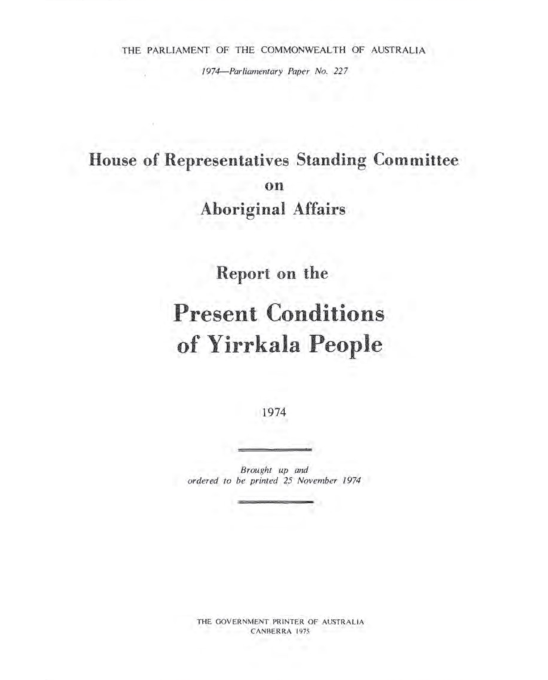
Report shows changing views of direct payments
A 1974 report about the impacts of bauxite mining on the Yirrkala community in Arnhem Land recommended against direct government payments for the community, reflecting a change from advice in a 1963 report.
At Yirrkala ... unemployment benefits, in the Committee’s opinion, should only be paid to people who meet the same criteria as apply to the rest of the Australian community.
| Attachment | Size |
|---|---|
| hor-report-on-yirrkala.pdf | 1.72 MB |
| Attachment | Size |
|---|---|
| hor-report-on-yirrkala-plaintext.docx | 64.43 KB |
In the 1960s, the government approved plans for bauxite mining in Arnhem Land in the Northern Territory. Yolŋu people of Yirrkala presented historic bark petitions to the government opposing the plans to mine their land and asking for a formal enquiry.
The government set up a Select Committee to look into the complaints. The committee made recommendations to government in 1963. In 1974, the Standing Committee on Aboriginal Affairs reviewed the progress of the 1963 recommendations and presented this report.
Some of the 1974 report’s recommendations opposed recommendations made in 1963, reflecting the shifting attitudes in government over the decade.
Both reports looked into how the mining activities impacted the community in relation to the environment, health, education, alcohol and government payments. They also discussed issues of land rights and mining royalties paid to the community. Both said the company, mission and government had not consulted enough with the Yirrkala community.
The reports also raised direct payments of social services. The 1963 report recommended that people of Yirrkala be paid government payments directly. The 1974 report noted that direct payments were now in place.
However, in general, the 1974 report was negative about people of Yirrkala getting payments, especially Unemployment Benefit. It said that the payment of this benefit would be a ‘sudden injection of funds’ which could have ‘undesirable effects’ on the community (Standing Committee 1974:49). The report said bauxite mining royalties should provide enough income, although it did call for an increase in royalty payments as well.
This source reflects shifting views about government payments to Aboriginal people in remote communities. This shift was from people getting more direct payments in the 1960s, to seeking control over who got payments by the 1970s.
In 1963, Yolŋu Elders of Yirrkala mission prepared a series of bark petitions to express their concerns to government about plans for mining in Arnhem Land. The 4 petitions included painted borders and Gumatj language.
You can view 2 of the original Yirrkala bark petitions online. See one petition held by Parliament House on the Documenting a Democracy website, and another petition held by the National Museum of Australia.
The Standing Committee was made up of members of parliament nominated by government and opposition. Ian Prowse, Assistant Director General (Policy) for the Department of Social Security, was listed as a witness in both 1963 and 1974. Prowse also gave evidence about social security before the Standing Committee in 1973 and 1975.
The full committee report is available on the Parliament of Australia website.
Citation
Standing Committee on Aboriginal Affairs (1974) Report on the present conditions of the Yirrkala people, Parl Paper 227/74, report to the House of Representatives, Australian Government, Canberra.
